Effects of Temperature to the Collector Urchin Tripneustes gratilla (Linnaeus, 1758) Two-Armed Larvae
DOI:
https://doi.org/10.61569/p7wk2674Keywords:
Climate change, Development stages, Ocean warming, Temperature toleranceAbstract
Shallow-water populations might be at particular risk with the predicted drastic global water temperature rise, which could cause high mortality rates among organisms at their early life stages, thereby limiting their distribution, growth, and survival. Recent studies about the thermal tolerance of the embryonic and larval stages of collector urchin highlighted the need to determine the thermal tolerance of T. gratilla larvae in the tropical region, particularly in the Philippines. In this study, the survival rates of the two-armed larvae of T. gratilla were investigated at various temperature ranges (low temperature: 19-23◦C; ambient temperature: 26-29◦C; and high temperature: 30-33◦C) under laboratory conditions. The survival of T. gratilla at two-arm larval stage was significantly lowest (15% ± 0.45 SEM at p<0.05) at high temperature range compared with the other treatments, suggesting that T. gratilla have limited thermal tolerance during the early stages of their life cycles. Findings of this study are important in determining the optimal temperature in the culture of T. gratilla, specifically in the early larval stage, and provide more insights on its thermal tolerance and sensitivity.
Downloads
Published
Issue
Section
License

This work is licensed under a Creative Commons Attribution 4.0 International License.
This is an open access article distributed in accordance with the Creative Commons Attribution 4.0 Unported (CC BY 4.0) license, which permits others to copy, redistribute, remix, transform and build upon this work for any purpose, provided the original work is properly cited, a link to the license is given, and indication of whether changes were made. See: Creative Commons Attributions 4.0 International License.








